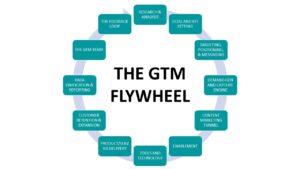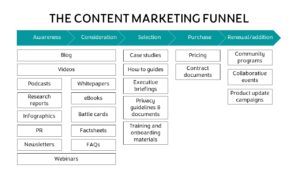Integrating Partnerships Into Your GTM Strategy

In the first article by Skalegrow on GTM (Go-To-Market), we went against some of the conventional thoughts in the space. We looked at a concept called ‘The GTM Flywheel’, where we discussed in detail why GTM is not a one-time activity and why it should work like a continuous engine. I suggest you give it a read first. Here is the link to the article:
The GTM Flywheel – Go To Market Strategy For New-age B2B Businesses
We will look at today’s topic through the lens of the flywheel in addition to covering a few best practices while integrating partnerships into your GTM engine.
What do I mean by partnerships?
The term partnership could take different meanings depending on how you view it. Following are the different types of partners you could work with:
- Partner companies with complementing products or capabilities
- Distributors or resellers of your solutions
- Product companies on which you have built your solutions (e.g. SAP implementation & consulting business)
- Companies or products you integrate your solutions with (e.g. a platform like GoToWebinar that comes with off-the-shelf integrations with HubSpot and Salesforce. An integration does not guarantee a partnership though).
Some also count individual partners, collaborators, and influencers into the lot. But I am considering only those types of companies that are not offering services to you but are expecting your reach or capabilities in return.
Fitting partnerships into the GTM flywheel
We will first look at the topic through the lens of The GTM Flywheel.

The GTM Flywheel
Where will partnerships fit in the flywheel?
Broadly speaking, it should be part of the entire GTM flywheel – meaning you need to design your GTM strategy by counting in partnerships as an essential element throughout the funnel.
Next, let us see how this manifests in each of the 12 components of the GTM flywheel.
1. Research and analysis
Research and analysis from a partnership point of view will involve hunting for potential partners that would complement your capabilities or accelerate your go-to-market efforts. In this step, you would consolidate information such as:
- List of potential partners and resellers.
- How each partner or reseller can help (for example, can you leverage a particular partner to help enter a new geography?).
2. Goal and KPI setting
This is something that needs to be done in collaboration with the partnership team. What would work best is for the partnership team to create a set of goals that would meet the needs of the GTM engine as well.
For instance, assume that the goal set for your GTM engine during the launch of a new solution is to create a pipeline of $5 million in 6 months. Now, as you distribute this among multiple channels, you can allocate a certain percentage of the target to the partnership team as well.
3. Targeting, positioning, and messaging
When it comes to targeting and positioning, can you guess where partnership plays a part?
There are two ways in which this could happen:
- You enter a particular market or your entire target market with your partners.
- You partner with a new company after you have entered at least one of the target markets.
Depending on the type of company you partner with, your target criteria might or might not change. Let us understand this through an example.
Imagine you are into selling software solutions in the cybersecurity space. You decide to partner with a company that offers secure networking hardware solutions before you go to market with your software.
In this case, your target criteria remain more or less the same. However, your positioning would now change from a security software company to one offering a complete suite of hardware and software security solutions.
The messaging would also change for every company you partner with – assuming each brings different value additions to the table. This could reflect at a company level or in partner-specific campaigns (or both).
4. Demand gen and capture engine
Integrating partnerships into your GTM strategy adds one more channel to your demand gen and capture engine. You can generate demand through collaborative activities like co-hosted webinars, joint product launches, PR campaigns, etc. The generated demand can be captured either through automations you set up or by manually adding leads to your CRM.
Related: B2B Demand Generation – How To Create A System For It
5. Content marketing funnel
In the context of integrating partnerships into GTM, it’s all about looking at new avenues for creating content for different stages of the buyer’s journey. Some examples include guest blogging (on each others’ websites), collaborative videos, appearing on each others’ podcasts, social media tagging, etc.

6. Enablement
Enablement in GTM is about ensuring that all the stakeholders involved in GTM activities have the right ‘weapons’ to perform their tasks. In partnerships, it is about offering the partnership team all the necessary resources such as people, budget, collaterals, and training to be able to contribute to the overall GTM game of the company.
7. Tools and technology
This doesn’t require an explanation. We discussed the GTM tech stack in the GTM flywheel article. You just need to extend the same to partnerships.
Does the partnership team need additional tools and tech to help with your GTM efforts? That’s what you need to figure out here.
8. Product/service delivery
Unless there is involvement from your partner’s side in delivering the solution you sold to a customer, there isn’t much to be done here from a partnership perspective. However, if partner help is needed, how effectively you collaborate with them will impact metrics like customer retention/churn rate, NPS score, average onboarding time, etc.
9. Customer retention and expansion
Partnerships can be used as an effective tool for customer expansion. Here are a couple of ways in which this can be done:
- Partnering with a company that brings complementary capabilities. This helps you to go after newer companies which otherwise would not have been possible.
- Expanding into a new market or geography where a partner company has a strong presence (and you don’t).
Customer retention works the same way. Your partner’s brand name and the customer experience it offers could help you retain more customers and reduce churn.
10. Data unification and reporting
A best practice here would be to look at data separately from a partnership perspective since that would make attribution much easier at a company level. It will also help the team measure the outcomes of its efforts. This is particularly helpful in companies where partnerships and alliances are a standalone function.
You also need to read this along with the goal-setting step, where you define some of the goals of the partnerships team in a way that they align with your GTM efforts.
11. The GTM team
If your company has a strong partner ecosystem, it is recommended to have a partner manager or the head of partnerships as a part of the GTM team. This will ensure that partnerships stay a strong pillar of the GTM team.
12. The feedback loop
The feedback loop in the case of partnerships is about ensuring interventions are made at the right time to ensure:
- New partners and partnership activities are initiated as and when required
- Existing partner programs are revisited if required.
Best practices while integrating partnerships into GTM
In the previous section, we understood how partnerships fit into the GTM game by analyzing how it works across the GTM flywheel. But to understand how partnerships as a function can make a difference to GTM efforts, we need to go a step further and look at best practices that can be put into action while implementing partner programs.
Here are some of my suggestions:
- Choose your partners wisely
- Define your partner team goals well
- Give value and get value
- Partnerships is not ABM
1. Choose your partners wisely
This is very obvious, but many tend to overlook this. Every business has different interests. If your partner’s interests don’t align with your GTM goals, there might not be a fit. Ask yourself the following questions:
- Can the partner add value to my business in the short term or long term?
- Can the ROI of this business relationship be justified?
- Can we as a company offer a tangible benefit in return to the partner organization?
Keeping these as filters will help you choose your partners in a way that it’s a win-win for both parties.
2. Define your partner team goals well
We already touched upon this in the previous section. If augmenting your GTM efforts is something you need from your partnerships team, that has to be communicated by defining goals accordingly. This is especially important in enterprise companies where silos are more common, and partnerships as a team tends to be misaligned with the rest of the organization.
3. Give value and get value
One of the most important pillars of a partnership is adding value to each other. This holds true in the case of a business partnership as well. Partnerships are not one-way engagements. Make sure you have something strong to offer your potential partners before you ask for a favor from them.
4. Partnerships is not ABM
I see this common tendency among partnership managers to use the function to tap into their partners’ target account list. While this can eventually happen, that’s not the first step you should take in a partner engagement.
You should rather focus on aspects like the alignment of values, mutual benefits/value adds, complementing capabilities, etc., while entering into a new partnership. Partnerships are not another ABM tactic. It’s more like they add to your ABM efforts, just like it does with GTM.
Final words
Different companies view partnerships differently. Some have it integrated into marketing, while others have it as a dedicated function. Most enterprise firms have a dedicated team for partnerships and alliances.
What we discussed in this article will apply to companies of all sizes. However, they work best for small to mid-size companies. This is because large companies have very diverse partner programs, which might require us to go a little deeper into the nitty gritty of things.
Whatever the case is, keep this basic principle in mind – GTM is a continuous process, engine, or flywheel. It’s not a one-time activity. Make it a practice to integrate partnerships into your GTM efforts and make GTM a key element of your partnerships strategy.
Skalegrow – B2B content marketing agency
With marketing getting tougher and tougher, every wrong foot you make might hamper your growth. What you need is the right guidance and a helping hand. This is where Skalegrow can make a sea of difference.
Skalegrow helps IT, tech, SaaS, and embedded systems companies leverage new-age marketing tactics to grow their business. Check out the below intro video to learn more about what Skalegrow brings to the table:
Content marketing is one of our focus areas and we are already helping some of our clients generate leads and improve brand awareness using high-quality content. Visit our content marketing services page to learn more about how we can help. You could also write to us at info@skalegrow.com.
About the author

Naseef KPO is the Founder and CEO of Skalegrow. He comes with rich experience across multiple areas of B2B marketing including content marketing, demand generation, SEO, account-based marketing, marketing analytics, revenue attribution, marketing technology, etc. He writes thought-provoking and relevant articles on The Skalegrow Blog and his weekly LinkedIn newsletter Elevate Your Marketing.
Prior to starting Skalegrow, Naseef led large marketing teams in multi-million dollar B2B organizations where he made significant contributions to the topline growth of the business. He has also appeared on numerous podcasts where he shared his thoughts on trending marketing topics such as the application of AI in marketing, startup marketing, ABM, and B2B content marketing, just to name a few. Being the founder of Skalegrow, he is currently focusing on helping its clients stay ahead of their competition by using innovative yet practical marketing tactics.
You can connect with Naseef KPO on LinkedIn.

John Doe
Habitant morbi tristique senectus et netus et malesuada fames ac turpis egestas. Nullam vehicula eros in suscipit fringilla. Aenean quis ex hendrerit, fringilla diam egestas, hendrerit nunc. Nunc at egestas magna. Nullam eu tempus ipsum. Pellentesque arcu mi, condimentum sit amet tincidunt eget, tristique sed turpis. Cras tempor mollis ultrices.





![How To Craft A Cold Email Sequence That Works [With Examples]](https://skalegrow.com/wp-content/uploads/2024/12/How-To-Craft-A-Cold-Email-Sequence-1024x576.png)


 your marketing
your marketing  new-age tactics?
new-age tactics?